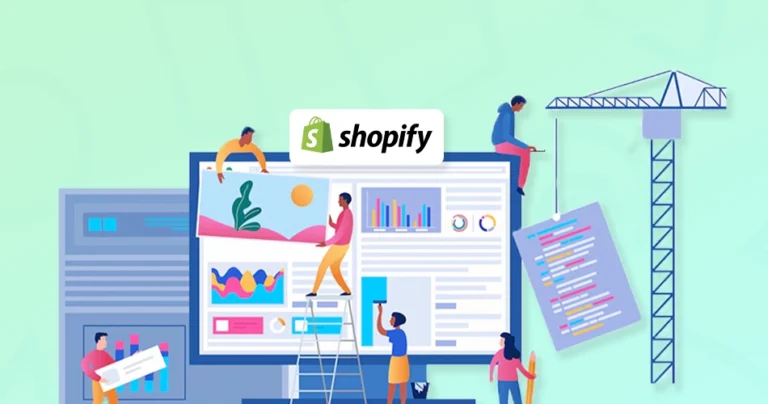Making changes to your live Shopify store feels risky. What if something goes wrong? What if the changes that you’re making don’t look good? One untested change could break your checkout, crash your theme, or worse, cost you sales during peak hours. That’s why experts never experiment on their production site.
For serious eCommerce operators, a staging site is more than just a testing ground. It’s an essential component of professional store management. This controlled environment allows merchants to validate changes with precision before exposing customers to potential disruptions.
In this blog, we will understand what a Shopify staging site is and why you should use it. We’ll also discuss how to create one. So, let’s dive in!
What is a Shopify Staging Site?
A Shopify staging site is like a safety net for stores. It’s a fully functional, private duplicate of your live store that exists solely for development and testing purposes. This isolated environment allows merchants to validate every change. It can be theme updates to app integrations. It completely shields the customer experience from potential disruptions.
For professional store owners, staging sites transform updates from high-risk maneuvers into controlled procedures. They eliminate the dangerous practice of making untested changes directly to production stores, where even minor errors can translate to lost sales and damaged brand reputation. Staging site is best when designing a Shopify store as it saves you from potential errors.
The staging environment provides three core business advantages:
- Risk Elimination: Test freely without revenue or customer experience consequences.
- Quality Assurance: Perfect changes before they impact conversion rates.
- Operational Confidence: Deploy updates knowing they’ve been thoroughly vetted.
Unlike development stores, staging sites maintain perfect synchronization with your live store’s configuration. They’re not for long-term development but rather for final pre-launch validation.
For scaling merchants, implementing a staging workflow is a recommended best practice. It represents the difference between hoping updates work and knowing they will.
Why Should You Use a Shopify Staging Site?
Let us discuss some prominent reasons why top-performing stores consider staging non-negotiable.
Risk-Free Deployment Safeguard
A staging site creates an essential buffer between development and production. It allows you to validate every update before it reaches customers. This controlled environment prevents revenue-killing scenarios. Examples include broken checkouts during peak sales periods or incompatible app integrations. These issues could take your store offline.
By testing changes in isolation first, you eliminate the guesswork from deployments. You gain confidence that updates won’t disrupt your live operations. For merchants processing orders daily, this protection alone justifies the staging setup investment.
Comprehensive Quality Assurance Platform
Professional stores require rigorous testing protocols. These protocols cannot be performed safely on a live site. A staging environment enables proper QA workflows. These include user acceptance testing, cross-browser and device compatibility checks, and performance benchmarking under simulated traffic loads.
You can verify how new features behave with existing apps. You can test checkout flows using dummy orders. You can stress-test your theme with extreme product variants. All of this happens without affecting real customers or analytics data.
Brand Experience Protection
Your store’s UX directly impacts conversion rates and customer loyalty. Staging lets you perfect every visual and functional element. You can test these changes before shoppers see them. You can check font rendering across devices. You can verify responsive breakpoints. You can ensure all interactive elements meet your quality standards.
This attention to detail prevents brand damage. This damage happens when customers encounter half-baked updates or obvious bugs. These issues can occur during their shopping journey.
Developer Efficiency Multiplier
For technical teams, staging environments provide a necessary infrastructure for modern development practices. Engineers can implement proper version control. They can conduct meaningful code reviews. They can troubleshoot issues without rushing against live site pressures.
The staging workflow enables continuous integration pipelines. With it, you can do A/B testing for more precise backend improvements. It allows safe experimentation with API integrations. All of this happens while keeping the production environment stable.
Scalability Foundation
As your business grows, so does the complexity of store updates. Staging becomes critical for managing major transitions like platform migrations, custom app development, or infrastructure upgrades. It allows parallel workstreams (e.g., marketing running promotions while developers implement new features) without dangerous cross-team interference.
For merchants planning international expansion or omnichannel integrations, staging provides the necessary testing ground to validate these strategic initiatives before committing valuable resources.
Simply put, for serious store owners, staging sites work like essential insurance. The few hours it takes to set up can save you from costly mistakes that damage sales and reputation.
Ready to test changes safely before going live?
What’s the Difference Between Development, Staging, and Live Sites?
Each environment serves a distinct purpose in building and maintaining your Shopify store:
Development Site
This is your digital workshop, a private space where developers create new features or modify existing ones. It’s disconnected from your live store, allowing for experimentation without consequences. Think of it as a blank canvas where all the initial building happens.
Staging Site
Your quality control checkpoint. This is an exact replica of your live store, where you test finalized changes before launch. Unlike the development environment, staging mirrors your current production setup to verify everything works as intended before going public.
Live Site
Your customer-facing store. It is the final product that processes real orders and generates revenue. Changes only reach this environment after passing through development and staging. This separation ensures shoppers always experience a polished, fully functional store.
Simply put, development is for creating, staging is for testing, and live is for selling. Moving changes through these environments in order creates a safety net that protects your business while enabling growth.
For expert help in setting up the staging or live site for your store, you can work with our Shopify development company.
How To Create a Shopify Staging Site?
There are 5 ways you can set up a Shopify staging site. Let us discuss them.
Method 1: Duplicate Your Current Theme
Start by creating a backup of your live theme. In your Shopify admin, go to Online Store > Themes, click “Actions” on your published theme, and select “Duplicate.”
This gives you a safe copy to experiment with while keeping your original theme intact. Rename it clearly (like “Staging – Summer Redesign”) so your team can identify it easily.
Method 2: Set Up a Development Store
Create a separate development store through your Shopify Partners account. This isolated environment lets you test themes, apps, and custom code without affecting your real store.
To do this, you need to:
- Sign up for a Shopify partner account. Install your theme.
- Now, go to Stores and then click Create Store.
- Choose Development as the store type.
- Give it a name like “Staging – Summer Redesign.”
- Now you can add products and configure all the settings to mirror your live store.
Method 3: Use Shopify CLI & Development Themes
For developers, Shopify’s command-line tools offer the most control. Install Shopify CLI to create development themes that sync directly with your code editor. This method lets you:
- Push changes instantly to your test environment.
- Collaborate with team members using version control.
- Test liquid code and custom features thoroughly.
Method 4: Use Third-Party Staging Services
Several specialized tools like GitHub, Beanstalk, or Theme Kit can streamline staging setup. These services are automatically:
- Create identical copies of your store.
- Track all changes between versions.
- Allow easy rollback if something goes wrong.
They’re ideal for merchants who want staging without technical hassle.
Method 5: Shopify Plus Sandbox (For Plus Merchants)
If you’re on Shopify Plus, you get a dedicated sandbox store. It is essentially a premium staging environment. This full replica of your store includes all apps and customizations, perfect for:
- Testing high-risk changes.
- Training new staff.
- Running mock sales events.
Your sandbox stays synced with your live store, minus the real transactions.
No matter which method you choose, always test these three critical elements before going live: checkout process, mobile responsiveness, and any app integrations.
Wrapping Up
Setting up a Shopify staging site might seem like extra work at first, but it quickly becomes one of your smartest business decisions. It works like your store’s insurance policy. The small amount of time you spend testing changes could save you from much bigger headaches later.
Make staging part of your regular workflow, and you’ll launch updates with confidence instead of crossing your fingers. Your customers will enjoy smoother shopping experiences, and you’ll avoid those panic moments when something breaks during a sale.
Need help in setting up a staging site for your Shopify store? Contact our experts today!
FAQs on Shopify Staging Site
Q1. Is a staging site really necessary for a small Shopify store?
Even small stores benefit from staging since one broken feature during peak sales can cost more than the setup. It’s cheap insurance that prevents revenue loss and protects customer trust when testing new changes. The few hours invested pay dividends in avoided emergencies.
Q2. Can I use a development store as my staging environment?
Yes, but with limitations since development stores lack certain live features and expire after 90 days. For permanent staging, use duplicate themes or dedicated staging apps that provide more reliable, long-term testing environments without expiration dates.
Q3. How often should I sync my staging site with my live store?
Sync whenever making significant product, collection, or setting changes, with monthly refreshes working for most stores. High-volume merchants should update weekly to ensure their staging environment accurately reflects current inventory and promotions.
Q4. Will staging slow down my workflow?
Initially, yes, but in the long term, it saves hours otherwise spent fixing live-site emergencies. Most merchants see ROI after avoiding just one major incident that could have crashed their checkout during a sale.
Q5. Can I test checkout functionality in staging?
Partially, you can test the visual flow using test mode, but real payment processing requires special setups. Shopify Plus sandboxes offer the most complete checkout testing, while development stores allow limited transaction simulations.
Q6. What's the biggest mistake merchants make with staging?
Not using it consistently for all changes, as skipping quick fixes is how most live-site breaks occur. Treat staging as mandatory for every update, no matter how small, to maintain reliable store operations and prevent costly downtime.





